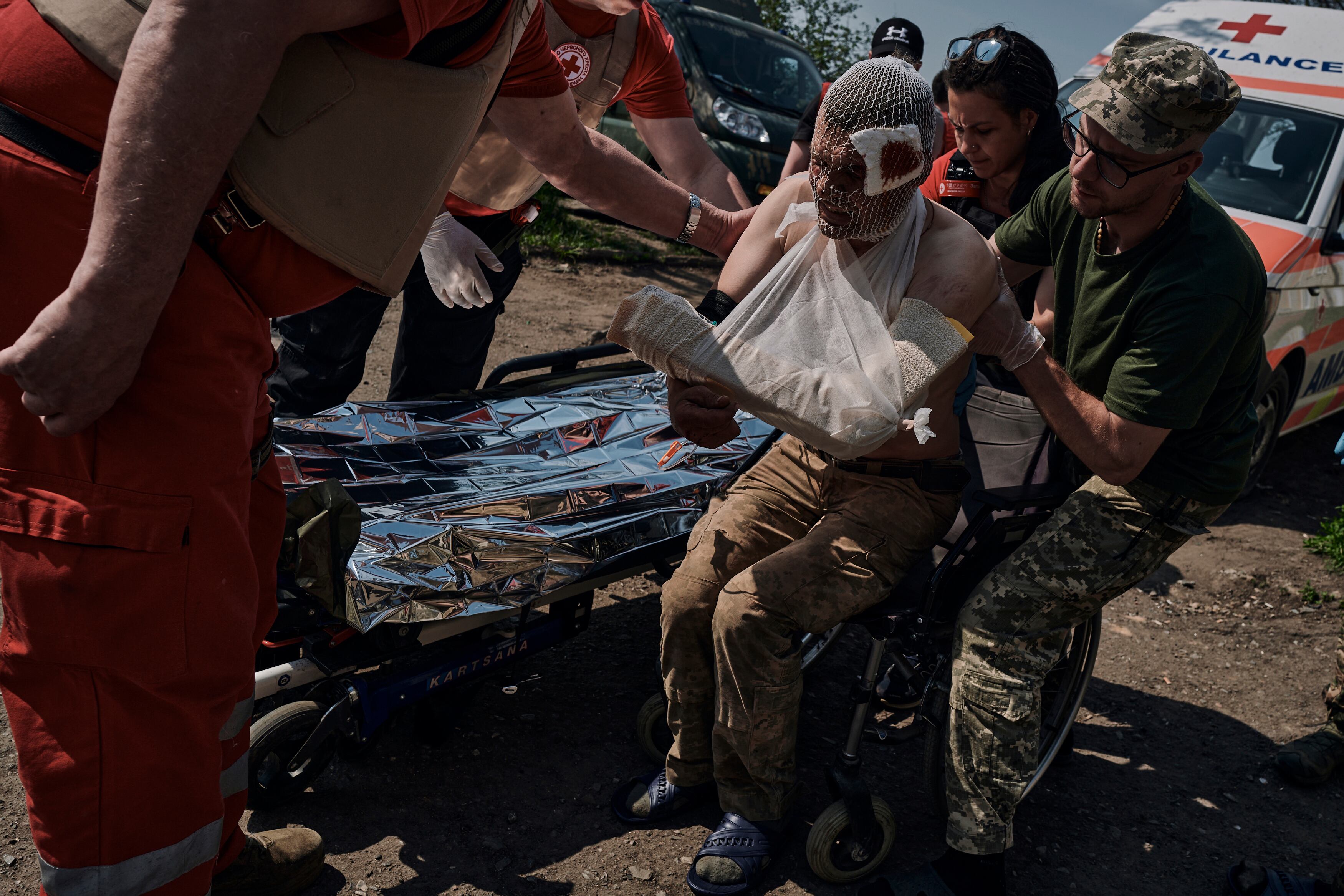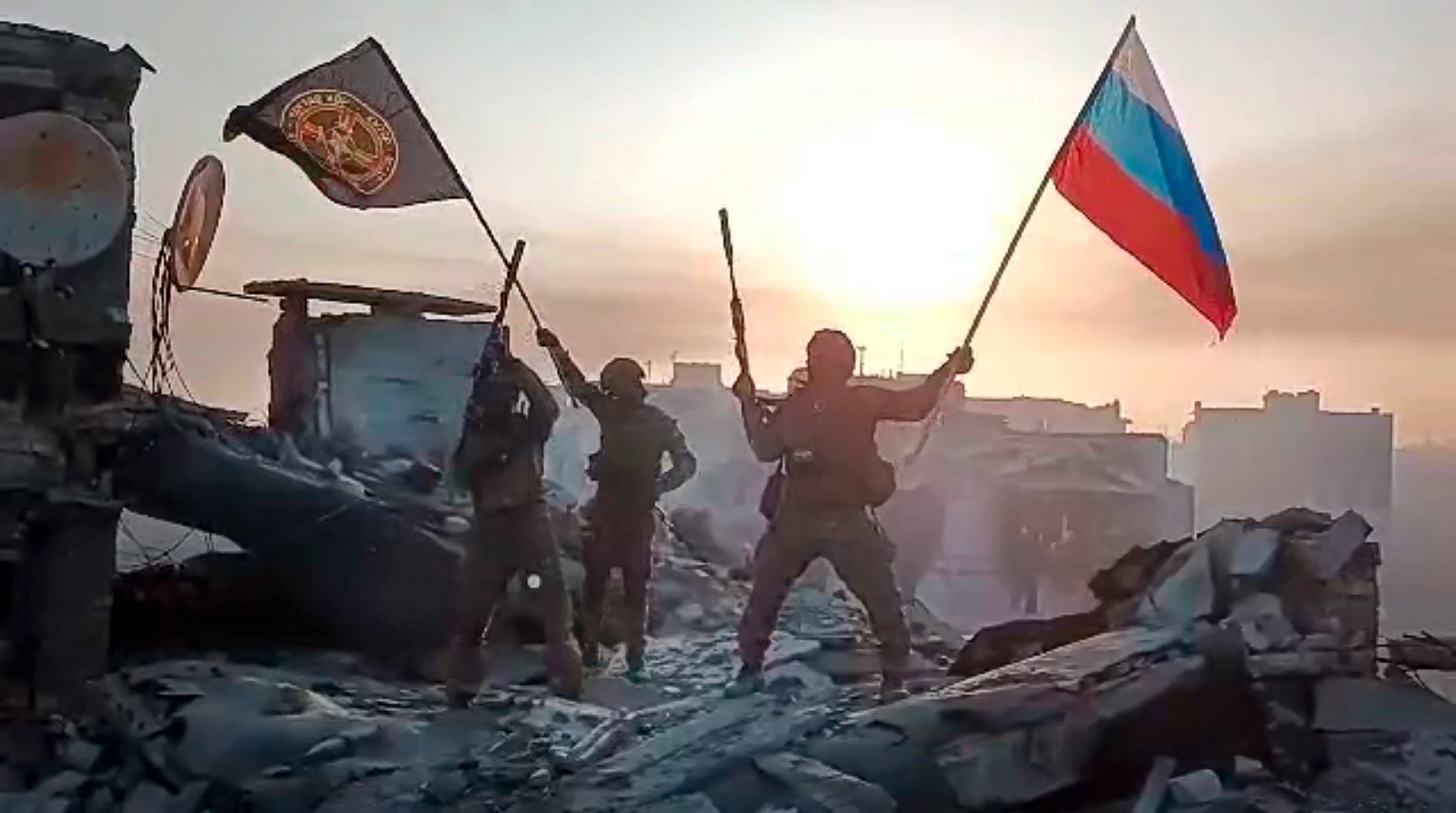BAKHMUT FRONTLINE, UKRAINE — “Ready! Fire! Glory to Ukraine!” an artillery officer with Ukraine’s 80th Air Assault Brigade shouts before he theatrically swings a large stick that looks like a baseball bat and the D-30 122 mm howitzer next to him fires. For months, this storied brigade, one of Ukraine’s most elite units, has been holding the line in and around the city of Bakhmut — and doing so with decades-old weaponry from Ukraine’s Soviet-era stockpiles, buying time for high-tech weaponry promised by the West to arrive for the much-vaunted spring offensive.
For a split second, a burst of flame engulfs our field of vision as the shell hurtles towards Russian positions just a few miles to our east. We are on the northern flank of the battle for Bakhmut, the focus of Russia’s renewed assault on the Donbas region of eastern Ukraine. The battle for the city has lasted roughly 10 months, with devastating casualties on both sides, and it’s become a symbol for both sides despite its relative strategic insignificance.
For the Russians, it has become a fixation, a point on the map to win to show Moscow that they can. The Ukrainians used that Russian obstinacy against them, forcing them to waste tens of thousands of troops, and tons of ammunition, to take an industrial town that’s not near any strategic road or waterway. The Biden White House estimates the Russians have lost 100,000 troops since December, including some 20,000 dead.
As of late May, the Russians are once again claiming they’ve taken the town, after forces on both sides traded fire in a deadly waltz, winning and then losing the same pieces of bombed and battered territory — apartment blocks and factories smashed into ruins, gardens turned into a maze of trenches. The locals have been driven out, if they were lucky, or left lying dead in the ruinous crossfire. A few hundred civilians remained hidden in bunkers and basements, some too terrified to leave, alongside others who were genuinely pro-Russian and believed in the Kremlin’s promised ‘liberation.’

This artillery duel between Ukraine and Russia’s antique Soviet arsenals has been a costly exercise in buying time. This brigade — along with other experienced Ukrainian units such as the legendary 93rd Hollodny Yar Mechanized Brigade and the 4th Tank Brigade — have held as much of the city, for as long as possible, until Ukraine is ready for a large-scale but much-delayed “spring” counteroffensive, with summer starting the third week of June.
President Volodymyr Zelenskyy said it was simply a matter of waiting for the promised new equipment to arrive, but Ukraine’s apparent performance anxiety has surely been driven by the West’s high expectations. Analysts like Michael Kofman, of the Center for Naval Analyses, have said the Ukrainians will only have enough weaponry and ammunition, and time, to launch one major offensive this year, using their newly arrived Western supplies and employing thousands of troops trained by the U.S. and UK among others.
And Ukrainian top brass knows the critics in Western capitals, like Republican lawmakers who oppose funding the war, will be merciless if they fail to make enough ground, or progress. The prospect of a second Donald Trump administration in 2024 is particularly worrying to them. The former president declined to tell a CNN Town Hall that he was in favour of Ukraine winning and said that the U.S, is sending too many weapons.
Facing that pressure, Kyiv’s shopping lists for its foreign partners keep expanding. More HIMARS ammunition, longer range missiles, more armored vehicles and, top of the list, F-16 fighter jets. European leaders, also fearful of a political upset in Washington, have been answering with billions in new promised aid, as Zelenskyy jetted from capital to capital in recent weeks.
Chancellor Olaf Scholz gifted Ukraine with a near doubling of military aid, worth nearly $3 billion, including 30 more tanks and over 100 more armored fighting vehicles. The United Kingdom and France for the first time agreed to send long-range cruise missiles, which can travel over 300km, allowing Ukraine to hit many previously out of range Russian logistical targets, in places like the city of Luhansk in Ukraine’s Donbas region.
And last week, Ukraine at last got the promises of F-16 fighter jets from European powers it has sought since the 2021 Russian invasion of most of the country.
As the weeks of shuttle diplomacy played out, the 80th held the line around Bakhmut with Soviet cast-offs and hand-me-downs from former Warsaw Pact states.
When I visited one of their positions near the north flank of Bakhmut, the Soviet-era D-30 howitzer being fired was of a model that first entered service in 1960. It is a reliable workhorse, an artillery equivalent of what the AK-47 is for assault rifles. The other heavy guns the soldiers tell me they use — the BM-21 “Grad” Multiple Launch Rocket System, and the 2S1 Gvosdika (“Carnation”) 122 mm howitzer, and close-range 120 mm mortars are also old Soviet relics.
These are the kinds of weapons and fighting U.S. troops would face, should NATO ever be drawn into a direct fight with Russian forces.

An artillery operator, Dima, said that while they look forward to using newer systems, he is comfortable with his weapon.
“I’ve been using this type of artillery for seven years.” he said. (Dima and others in the 80th chose to identify themselves by only their first names to protect themselves in case of Russian capture.)
Like the 80th, most Ukrainian units in the region have been almost entirely dependent on Soviet Era T-72 tanks, whether from Ukraine’s old stockpiles, former Warsaw Pact members like Poland, or captured Russian vehicles. When I visited the positions of the 3rd Tank Brigade in the Kharkiv region, most of the tanks were modified T-72 variants, many from the former Yugoslav army that were decommissioned after the Balkan Wars and passed through Romania.
“The strategic goal of the 80th Air Assault Brigade is to make it impossible for the Russians to surround Bakhmut, or to cut it off” said Kateryna, a spokesperson for the unit who accompanied Military Times on our trip to their positions. The troops knew they might ultimately lose, but in holding the land, they’ve forced the Russians to use troops they might have used on a second offensive this year — an offensive that U.S. Director of National Intelligence Avril Haines says is unlikely due to Russia’s high casualty rate and “personnel and ammunition shortages, dysfunction within the military’s leadership, exhaustion, as well as morale challenges.”
Pushing Russia back, time and again
The 80th Air Assault Brigade is one of the most battle-hardened groups of soldiers in Ukraine’s entire armed forces. Dating from the Soviet era, the unit has fought Russian-backed proxies in Donbas since 2014.
“From the very first days of the full-scale invasion, our brigade was involved in the defense of Southern Ukraine — in Voznezensk, in Kakhovka and in Kherson oblast,” spokesperson Kateryna said.
The unit gained fame for its clever use of scouting drones and artillery to destroy two Russian battalion tactical groups that were attempting to cross the Sivirsky Donets river with pontoon bridges near the town of Bilohorivka. In a battle lasting eight days, Ukrainian forces in the area destroyed around 70 Russian armored vehicles and killed up to 550 Russian soldiers.
These feats were impressive — but in the conditions of Bakhmut, they are hard to replicate. Russian forces, including mercenaries from the Wagner Private Military Group, claim to have conquered the city. Ukraine’s top regional commander, Colonel General Oleksandr Syrsky admitted the city is largely under Russian control as he toured front-line positions near Bakhmut.

As Kateryna explains it, they have been the linchpin in the defense of Bakhmut’s “road of life,” from the city of Konstantinyvka, through the town of Chasiv Yar, to the last remaining positions inside the city of Bakhmut itself. This “road,” more a dangerous series of muddy dirt tracks that are out of Russian line of sight but within range of unguided artillery fire, transport ammunition and supplies into the city, while military ambulances ferry large numbers of wounded in the other direction. In March, many feared the Russians would cut these roads, potentially trapping thousands of Ukrainian soldiers in the city, as they had done in Mariupol. But through tenacious fighting, the Ukrainians kept these lines of supply open, even gaining ground back. Despite their reportedly high casualties, which they decline to discuss per Ukrainian military regulations, the troops are bullish on their prospects as the offensive approaches.
“We are even slowly moving forward, taking a hundred meters here, a few dozen here, with tactical offensive actions” Kateryna tells me. Since my visit, they have picked up the pace, with the Ukrainians having taken several miles of ground to the north and south of Bakhmut.
What keeps the soldiers going, they tell me, is keeping their families safe from the hell they are fighting through. As Dima explains to us from the relative safety of an underground trench, he has a 7-year-old daughter back at home. He’s in the trenches in the hope of keeping this nightmare from reaching her.
And they are fighting in memory of their own fallen. As the Ukrainian soldiers’ scramble to reload the gun, one of the soldiers shows me the casing of a shell pulled from an ammunition crate stored nearby. The words “For Chuba Sasha, we won’t forgive,” with the date April 12, 2022, the day of his death, are written on it. We hear a spotter reading coordinates, before the gun fires again.
“Hellish battles are going on, but we are fighting for every meter,” said a 32-year-old local commander who gave his name as Misha. The intensity of the fighting varies noticeably, he said, with upticks both when they receive artillery ammunition deliveries and when the Russians they are fighting get supplied.
“Of course, their guns can reach us here easily, but we are not scared,” he said. “We are never scared when we are on our own land.”





